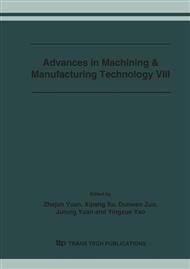p.123
p.127
p.131
p.136
p.140
p.145
p.150
p.154
p.159
FEM Simulation of the Residual Stress in the Machined Surface Layer for High-Speed Machining
Abstract:
An orthogonal cutting model was presented to simulate high-speed machining (HSM) process based on metal cutting theory and finite element method (FEM). The residual stresses in the machined surface layer were obtained with various cutting speeds using finite element simulation. The variations of residual stresses in the cutting direction and beneath the workpiece surface were studied. It is shown that the thermal load produced at higher cutting speed is the primary factor affecting the residual stress in the machined surface layer.
Info:
Periodical:
Pages:
140-144
Citation:
Online since:
July 2006
Authors:
Price:
Сopyright:
© 2006 Trans Tech Publications Ltd. All Rights Reserved
Share:
Citation:


